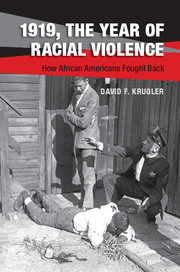Book contents
- Frontmatter
- Dedication
- Contents
- Acknowledgments
- Source Abbreviations and Usage Note
- Introduction
- 1 World War I and the New Negro Movement
- 2 “We Return Fighting”
- 3 Fighting a Mob in Uniform
- 4 Blood in the Streets
- 5 Armed Resistance to the Courthouse Mobs
- 6 Armed Resistance to Economic Exploitation in Arkansas, Indiana, and Louisiana
- 7 “It Is My Only Protection”
- 8 The Fight for Justice
- 9 The Fight for Justice
- 10 Fighting Judge Lynch
- Conclusion
- Bibliography
- Index
- References
2 - “We Return Fighting”
The First Wave of Armed Resistance
Published online by Cambridge University Press: 05 December 2014
- Frontmatter
- Dedication
- Contents
- Acknowledgments
- Source Abbreviations and Usage Note
- Introduction
- 1 World War I and the New Negro Movement
- 2 “We Return Fighting”
- 3 Fighting a Mob in Uniform
- 4 Blood in the Streets
- 5 Armed Resistance to the Courthouse Mobs
- 6 Armed Resistance to Economic Exploitation in Arkansas, Indiana, and Louisiana
- 7 “It Is My Only Protection”
- 8 The Fight for Justice
- 9 The Fight for Justice
- 10 Fighting Judge Lynch
- Conclusion
- Bibliography
- Index
- References
Summary
During World War I, African Americans resolved to make America safe for democracy. Four outbreaks of violence resulting from the enforcement of white supremacy between December 1918 and early July 1919 demonstrated just how difficult it would be for African Americans to secure equal rights and opportunities. In each instance, however, blacks fought back against their attackers: in Charleston, South Carolina (twice); in Bisbee, Arizona; and in Longview, Texas. The variety of the resistance reveals the determination of African Americans across the South to stand up to white supremacy. In Charleston’s first riot, in December 1918, black soldiers briefly joined together with white servicemen to halt a white police officer’s abuse of a black private. By late May 1919, when Charleston experienced a second riot, this biracial esprit de corps had evaporated, replaced by the unity of white civilians and servicemen, who joined together to attack the city’s black residents. Not intimidated, black Charlestonians defended themselves. Six weeks later, a white mob comprised of civilians, soldiers, and law enforcement officers targeted the men of the Tenth Cavalry, a black army unit stationed at Fort Huachuca, Arizona. The troopers, asserting their rights as soldiers, resisted a forcible seizure of their sidearms by sheriff’s deputies and police during a Fourth of July celebration in nearby Bisbee. Just a few days later, armed black men in Longview, Texas, successfully dispersed a lynch mob intent on punishing a prominent black resident for his perceived affront to whites.
African Americans had returned fighting, as W. E. B. Du Bois observed in the May 1919 Crisis: “We return from fighting. We return fighting. Make way for Democracy! We saved it in France, and by the Great Jehovah, we will save it in the United States of America, or know the reason why.” Du Bois might well have added: “We remain fighting.” For almost all of the African Americans who resisted white mob violence in Charleston, Bisbee, and Longview had remained in the United States during the war. Black veterans of the Western Front would play a significant role in armed resistance later in 1919, but during these early months, as these veterans were on their way home, civilians and servicemen stationed at domestic bases provided the first wave of armed resistance.
- Type
- Chapter
- Information
- 1919, The Year of Racial ViolenceHow African Americans Fought Back, pp. 35 - 65Publisher: Cambridge University PressPrint publication year: 2014



